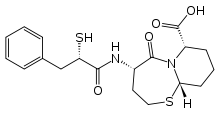Omapatrilat
 | |
| Systematic (IUPAC) name | |
|---|---|
| (4S,7S,10aS)-5-oxo-4-{[(2S)-3-phenyl-2- sulfanylpropanoyl]amino}-2,3,4,7,8,9,10,10a-octahydropyrido[6,1-b] [1,3]thiazepine-7-carboxylic acid | |
| Clinical data | |
| Identifiers | |
|
167305-00-2 | |
| None | |
| PubChem | CID 656629 |
| ChemSpider |
570983 |
| UNII |
36NLI90E7T |
| ChEMBL |
CHEMBL289556 |
| Chemical data | |
| Formula | C19H24N2O4S2 |
| 408.534 g/mol | |
|
SMILES
| |
| |
| | |
Omapatrilat (INN) is a novel antihypertensive agent that inhibits both neutral endopeptidase (NEP) and angiotensin converting enzyme. NEP inhibition results in elevated natriuretic peptide levels, promoting natriuresis, diuresis, vasodilation, and reductions in preload and ventricular remodeling.
This drug from Bristol-Myers Squibb was not approved by the U.S. Food and Drug Administration due to angioedema safety concerns.[1]
Omapatrilat angioedema was attributed to its dual mechanism of action, inhibiting both angiotensin converting enzyme (ACE), and neutral endopeptidase, both of these enzymes are responsible for the metabolism of bradikinin which causes vasodilation, angioedema, and airway obstruction.
Clinical uses
The drug was promoted for possible uses in congestive heart failure.
References
- ↑ Joshi Venugopal. (2003) Pharmacological modulation of the natriuretic peptide system. Expert Opinion on Therapeutic Patents 13:9, 1389